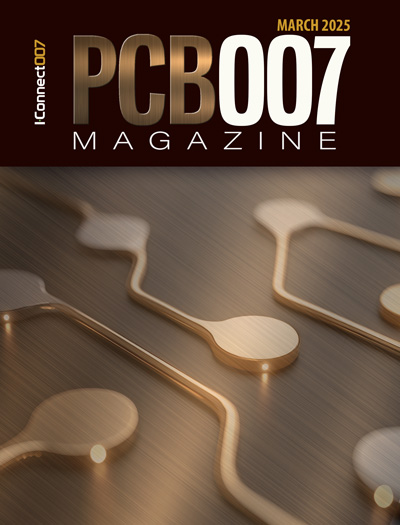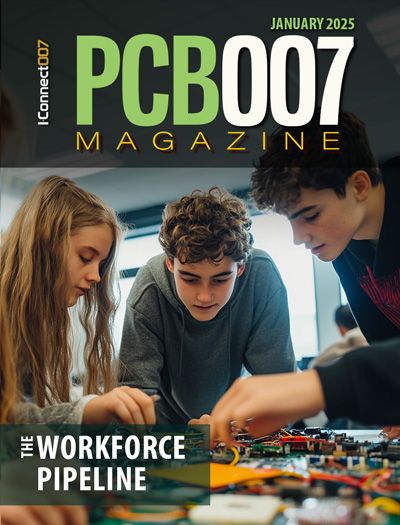-

- News
- Books
Featured Books
- pcb007 Magazine
Latest Issues
Current Issue
The Essential Guide to Surface Finishes
We go back to basics this month with a recount of a little history, and look forward to addressing the many challenges that high density, high frequency, adhesion, SI, and corrosion concerns for harsh environments bring to the fore. We compare and contrast surface finishes by type and application, take a hard look at the many iterations of gold plating, and address palladium as a surface finish.

It's Show Time!
In this month’s issue of PCB007 Magazine we reimagine the possibilities featuring stories all about IPC APEX EXPO 2025—covering what to look forward to, and what you don’t want to miss.

Fueling the Workforce Pipeline
We take a hard look at fueling the workforce pipeline, specifically at the early introduction of manufacturing concepts and business to young people in this issue of PCB007 Magazine.
- Articles
- Columns
Search Console
- Links
- Media kit
||| MENU - pcb007 Magazine
NASA’s Roman Mission Gets Cosmic ‘Sneak Peek’ From Argonne Supercomputer
June 14, 2024 | BUSINESS WIREEstimated reading time: 2 minutes
Researchers are diving into a synthetic universe to help us better understand the real one. Using the Theta supercomputer at the U.S. Department of Energy’s (DOE) Argonne National Laboratory in Illinois, scientists have created nearly four million simulated images depicting the cosmos as NASA’s Nancy Grace Roman Space Telescope and the Vera C. Rubin Observatory in Chile, jointly funded by the National Science Foundation (NSF) and DOE, will see it.
“Using Argonne’s now-retired Theta machine, we accomplished in about nine days what would have taken around 300 years on your laptop,” said Katrin Heitmann, a cosmologist and deputy director of Argonne’s High Energy Physics division who managed the project’s supercomputer time. “The results will shape Roman and Rubin’s future attempts to illuminate dark matter and dark energy while offering other scientists a preview of the types of things they’ll be able to explore using data from the telescopes.”
The team is releasing a 10-terabyte subset of this data, with the remaining 390 terabytes to follow this fall once they’ve been processed.
For the first time, this simulation factored in the telescopes’ instrument performance, making it the most accurate preview yet of the cosmos as Roman and Rubin will see it once they start observing. Rubin will begin operations in 2025, and NASA’s Roman will launch by May 2027.
The simulation’s precision is important because scientists will comb through the observatories’ future data in search of tiny features that will help them unravel the biggest mysteries in cosmology.
Roman and Rubin will both explore dark energy — the mysterious force thought to be accelerating the universe’s expansion. Since it plays a major role in governing the cosmos, scientists are eager to learn more about it. Simulations like OpenUniverse help them understand signatures that each instrument imprints on the images and iron out data processing methods now so they can decipher future data correctly. Then scientists will be able to make big discoveries even from weak signals.
Then they’ll continue using simulations to explore the physics and instrument effects that could reproduce what the observatories see in the universe.
It took a large and talented team from several organizations to conduct such an immense simulation.
“Few people in the world are skilled enough to run these simulations,” said Alina Kiessling, a research scientist at NASA’s Jet Propulsion Laboratory (JPL) in Southern California and the principal investigator of OpenUniverse. “This massive undertaking was only possible thanks to the collaboration between the DOE, Argonne, SLAC National Accelerator Laboratory and NASA, which pulled all the right resources and experts together.”
Suggested Items
Universal Avionics Connected FMS Certified on Part 25 Aircraft Models
04/01/2025 | Universal AvionicsUniversal Avionics (UA), an Elbit Systems company, today announces that FAA certification has been achieved for the installation of its Wi-Fi-enabled Flight Management System (FMS) on Part 25 aircraft models. The Approved Model List Supplemental Type Certificate (AML STC) serves as the foundation for the deployment of Universal’s Connected Avionics onto aircraft.
L3Harris Completes Sale of Commercial Aviation Solutions Business to TJC for $800 Million
03/31/2025 | BUSINESS WIREL3Harris Technologies has completed the previously announced sale of its Commercial Aviation Solutions (CAS) business to an affiliate of TJC L.P. for $800 million. The entire $800 million cash purchase price was paid to L3Harris at the closing of the transaction.
Koh Young Presenting on Real-Time Process Optimization at SEMI Heartland 2025
03/25/2025 | Koh YoungKoh Young, the global leader in True 3D measurement-based inspection and metrology solutions, is pleased to announce that Luis Rivera, MES Team Leader at Koh Young America, will speak at SEMIEXPO Heartland 2025, taking place March 31 to April 2 in Indianapolis, Indiana at the Indiana Convention Center.
Dr. Thomas Marktscheffel of ASMPT Honored for his Work on Open Interfaces
03/25/2025 | ASMPTDr. Thomas Marktscheffel, Director Product Management Software Solutions at ASMPT, was honored by the IPC at this year's IPC APEX EXPO in Anaheim, California, for his many years of commitment to the organization. The non-proprietary interface standards he helped develop form the basis for ASMPT’s intelligent factory concept.
New Power Management Chips from TI Maximize Protection, Density and Efficiency for Modern Data Centers
03/24/2025 | Texas InstrumentsTexas Instruments (TI) debuted new power-management chips to support the rapidly growing power needs of modern data centers. As the adoption of high-performance computing and artificial intelligence (AI) increases, data centers require more power-dense and efficient solutions.


